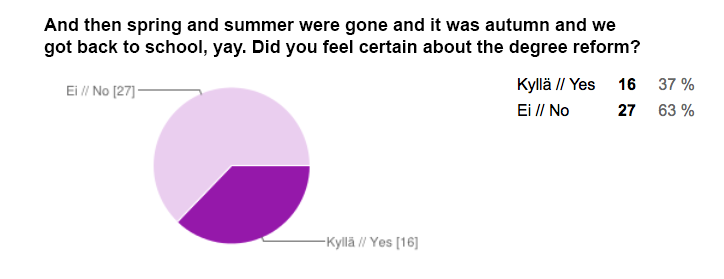Alongside everything else TOKYOs board made couple of questionnaires during the year of 2014. The answers are revealed right about now. As you may guess from the title, this text discusses the responses of TOKYOs degree reform survey from spring 2014. The results of the campus-questionnaire can be found here. The outcome of the exchange studies -questionnaire is here.
Hello holalalala
TOKYO’s last year’s board is already retired, but theres still something to share about the degree reform poll that we had open last December. We got lots of answers from the students (43 precisely, thank you all!) and one lucky person won a 100e gift card to Aalto ARTS Books :———)
All the Aalto ARTS departments and twenty different schooling programs were represented in the answers. It’s obvious that the degree reform still causes much confusion for the students, so here are some questions and answers from the degree reform questionnaire in a simple form. As you are nice and important for us, we also want to give you some knowledge and links, so you can check for more detailed information.
Yours sincerely, Olli-Pekka Peltomäki, school politics, TOKYOs board 2014
—
Respondents had started their studies between the years 2007 and 2014 and 65% of them were Bachelor students, 35% Master students. Studying under the new degree structure seems to be a little bit more popular than under the old one (19vs18), even though only seven of the students had started their studies in the autumn 2014. Therefore, many of the old students had tranferred to the new degree already. Six of the respondents didn’t know under which degree structure they were studying at the moment when they filled the questionnaire in.
“No! We should have been informed about the change of the degree structure when we were applying to school. I was promised a study right of four years when accepted the place in the textile art study program. I was fooled, as in practical terms my study right ends already in next autumn at the same time with the schooling program.”
– MA student, Textile Art and Design, answering a question if there was enough general about the degree reform in advance
Feedback for the upfront information about degree reform varied a lot. School sent an info letter to all the students in the late winter 2014 and scattered information was already then in Into and Inside (did you know that you can log in to Inside with your Aalto-account? Sometimes the school staff forgets that the official channel of communication for students is Into, and the information sticks only to Inside…). Still, students felt that the letter and other communications were hard to understand. About 2/3 of the old students (that had started their studies before autumn 2014) had attended the info event that departments and OOP arranged together. These so called group-PSPs (PSP = Personal Study Plan) got both positive and negative feedback. Students would have hoped information in a very simple form and a lot earlier, especially about the transition periods. The transition period for BA students ends 31.10.2016 and for MA students 31.10.2015. The last date to submit the BA thesis is 8.10.2016 and for the MA thesis it is 31.8.2015.
“It would be about the time to inform us whether it’s possible to submit the MA thesis after summer 2015 or not!!!!”
– MA student, Textile Art and Design (as an anwer for this one upset student colleaque: yes it is :—)!)
Some answers said that in the info event students were suggested to switch to the new degree structure without explaining it any further. Many answers mentioned that also the teachers seemed to be a little uncertain about many things. This might be because the process was still quite in the beginning.
“Information was clear as far as it existed. In many ways it felt like the school staff was as confused as the students who took part.”
– MA student, Art Education
About two thirds of the old students were not offered a possibility to have a personal study plan meeting because of the degree reform. In Feburary 2014, a planning group was trying to find out how to arrange the PSPs in different departments. Because of the strict schedule, most schooling programs couldn’t arrange PSPs for all of their students. However, about one third of the respondents had updated their PSPs and felt that it was beneficial.
Half of the students knew they would graduate under the new degree structure and one fourth under the old one. The last fourth didn’t know under which degree structure they would graduate. However, 77% felt that the degree reform hadn’t affected their studies, which might be a good thing. Most of the rest felt that it had, negatively, but we got also two positive answers.
When we asked the students how many of them will transfer to new a degree structure during their studies, answers went even: one third will, one third won’t and one third didn’t know yet. Only one third of the students said that transition periods will affect their studies. The transferring to a new program is done after you apply for it by yourself. You can get more information about this from the PSP meeting and from your study coordinator. Please note that you can’t go back to the old program afterwards.
Our open question about minor studies stirred up many kinds of feelings. Briefly: ”Good thing!”, ”Disaster. –” and ”WHAT MINOR STUDIES?!”. Some of the students didn’t know at all how the minor studies will change. In the new degrees, doing a 15-25 ects minor is mandatory. Different minors are listed here (with descriptions and more information here). Note that you can choose to study your minor in whichever Aalto University school you want, not only in Aalto ARTS.
Some students had had problems with combining minor courses and their major studies:
“A hell of a mess. Fitting this inside your timetable is really difficult. Apparently this wasn’t coordinated almost at all. The question is why renew, if it’s not possible to think stuff through first?”
– BA student, Arcitecture
Speak with your study coordinator or tutor teacher before starting the minor studies, it might need a little finetuning in the beginning…
Course substitutions weren’t a concern for half of the students. One fourth mentioned that everything was fine with them and the rest have had some problems. Detailed information about course substitutions aren’t too easily found in English, but some general info is located here. Again, personal study plan meeting is the thing to start with.
Most students couldn’t say if the degree reform had made their own schooling programs better. New degree structures got both positive and negative feedback, but a common thought seemed to be that the whole process had gone too fast and many things were still unclear.
“I hope that things will gradually become clearer. Furthermore, I hope that both, a decent PSP-session and a presentation of the minor studies would be organized also for us new students.”
– BA student, Design






